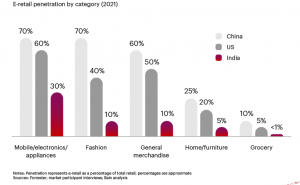
India had 180–190 million online shoppers in 2021, making it the third-largest market globally. India’s online retail market was worth $40 billion in 2021 and is expected to touch $50 billion this year. The country is set to overtake the US in the next two years to become the second largest online shopping market behind China, according to a study by Bain and Company. Rising affluence among India’s middle class will boost the e-tail market to $150–$170 billion a year by 2027, says the study.
There is a major downside to the growth in online retail segment. The anti-competitive practices by the large players are queering the pitch for smaller players in the space as well as traditional retailers. There are several other issues that need to be addressed by the Narendra Modi government to ensure that all players benefit from the e-commerce boom. There is a clear need to break the monopoly position enjoyed by few players. A report by the parliamentary standing committee on commerce had echoed these concerns.
READ | Global Hunger Index data suffers from quality, relevance issues
An important topic of discussion in the parliamentary panel report is how to help sellers not to remain confined to offline stores. Stringent regulatory requirements pose a big challenge to many retailers, stopping them from joining the tribe of ecommerce players. The report says the channel remains inaccessible to small players. This has denied growth opportunities to smaller players.
Industry insiders now advocate the revival of businesses that can be viable on ecommerce platforms. Small business owners need to be educated on the opportunities available. There is also a need for finetuning GST, bringing offline and online parity, and setting up a GST tribunal. To benefit from the ecommerce boom, both offline and online market players should have a uniform set of principle guidelines and regulations.

GST currently has an offline-online disparity which is hindering growth prospects of many players. Under the current GST regime, all online sellers, irrespective of their turnover, need to comply with GST registration and costs. On the other hand, offline retailers need to comply only if they have annual sales higher than Rs 40 lakh.
As the recommendations made in the standing committee report will affect every stakeholder in the sector, it is important that the committee shifts its gaze from what is evident to more burning issues. Take for instance the entry level hurdles that companies face. There is a mushrooming of companies which, despite their willingness to sell online, are restricted by the complexity associated with the compliance requirements and a lack of knowhow. Afterall, not everyone has the resources or financial capital to reach out to experts to understand the finer details of compliance.
Hence, instead of just focussing on improving the ease of doing business for bigger players and wooing them, the policymakers need to acknowledge and resolve the issues of smaller sellers who join the online economy.
Issues with Indian ecommerce sector
The rise of ecommerce in India also came with a set of challenges. The biggest one was dominance of bigger players such as Amazon and Flipkart. A few players have a stranglehold over a large part of the online market. This not only makes them indispensable for sellers as well as business users, but also to consumers who rarely look behind such platforms while placing orders from companies.
Consequently, numerous allegations of anti-competitive and unfair trade practices such as deep discounting, preference of private labels owned by platform operators, and zero transparency regarding search rankings and reviews. The government is presented with the challenge of tackling the issue while also not hurting the business sentiments.
READ | Amid hunger index row, concerns over plummeting foodgrain stocks
A government-appointed committee on the ecommerce sector has raised some other issues in the e-commerce marketplace. These include digital exclusion of MSMEs, IPR infringements, gaps in the current regulatory and enforcement mechanisms as well as procedural issues in logistics, courier services, GST regime and e-commerce exports.
India had the third-largest online shopper base of 150 million in FY21. The base is expected to become 350 million by FY26. The overall ecommerce market in the country is slated to reach $350 billion by 2030. India witnessed a boom after the rise in internet penetration, thanks to dirt cheap data. With increasing usage of smartphones and the government’s Digital India push, the country has become a hot market for foreign companies as well. Similar case was also seen for domestic players which now have access to a large chunk of India’s 140 crore population.
India’s e-commerce sector has now transformed the way business is done in the country. It has opened avenues for even small retailers which once could not even dream of tapping India’s vast market. Various segments of commerce ranging from business-to-business (B2B), direct-to-consumer (D2C), consumer-to-consumer (C2C) and consumer-to-business (C2B) are now viable.
